2.5.2 Administrator Course Database Management
The first time the Scheduling Administrator chooses the Course Database management operation, the software displays the following window:
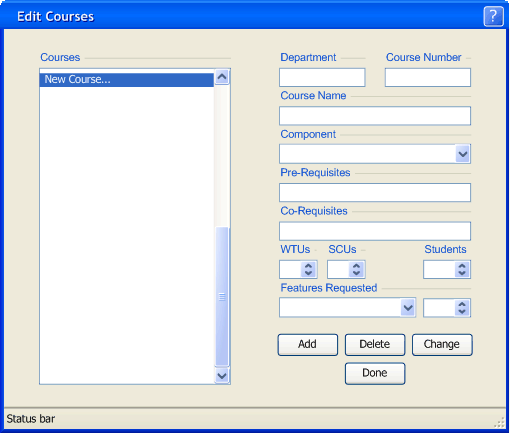
Figure 2.5.2.1: Initial View of Course Database Management Interface
The scrolling list box on the left shows all the Course Records currently in the Course Database used by the Scheduler Tool in alphanumeric order. On the right are the nine data fields corresponding to each Course Record:
- Department
- Course Number
- Course Name
- Component
- Pre-Requisites
- Co-Requisites
- WTUs; SCUs
- Students
- Features Requested
The Scheduling Administrator also uses four buttons to edit the Course Database. The 'Add' button lets the Scheduling Administrator add a course to the Course Database. The 'Delete' button removes a course from the Course Database. The 'Change' button changes the properties of the course selected from the left-hand list. The 'Done' button closes the window.
Adding a Course
In this scenario, the Scheduling Administrator creates a record for Lab course CPE 315. For purposes of illustrating list sorting only, the figures below show three Course Records in the Course Database already: CPE 101, 102, and 315, all lecture components. These entries have no bearing on the actions taken by the Scheduling Administrator or subsequent results.
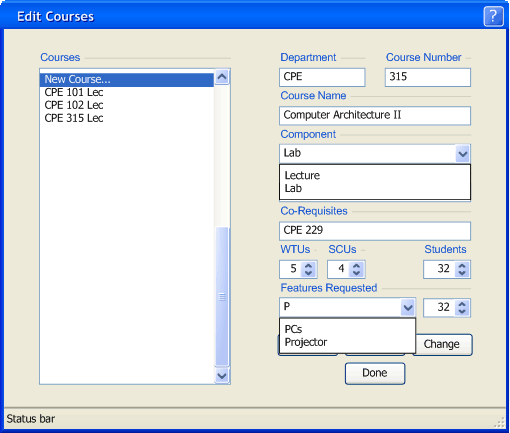
Figure 2.5.2.2: Example of Adding a Course
To add a course to the Course Database, The Scheduling Administrator first double-clicks on the New Course... entry in the list on the left. The software then clears all the values in the fields on the right, and the cursor is placed into the text box labeled "Building", where editing of each field then begins.
- Department
- This is the acronym for the Department associated with the course; The Scheduling administrator enters it as a string of characters, in this case CPE.
- Course Number
- This is the number associated with the course itself; The Scheduling administrator enters it as a string of characters, in this case, 315.
- Course Name
- This is the catalog name of the course; The Scheduling administrator enters it as a string of characters, in this case Computer Architecture II.
- Component
- Each course offering at the university has a Lecture/Activity or Lab component associated with it; the Scheduling Administrator selects either Lecture or Lab from the combo box.
- Pre-Requisites; Co-Requisites
- This field designates the courses that must be taken prior to or concurrently with the course being added. The system administrator enters these as comma-delimited strings of characters containing the department name, a space, and the course number. NOTE: if course names already exist in the database (as in this scenario), the software will display a list of all existing items that start with the characters already typed. For this scenario, the System Administrator types CPE 103, CPE 229 into the Pre-Requisites field and CPE 229 into the Co-Requisites field.
- WTUs; SCUs
- These fields designate the Weighted Teaching Units (WTUs) and Student Course Units (SCUs) associated with the course being added. The Scheduling administrator selects two decimal numbers corresponding to the department's defined value for each, in this case 5 and 4.
- Preferred Number of Students
- This is the number of students the Scheduling Administrator has determined to be optimal for the particular course; the Scheduling administrator enters this value as an integer, in this case 32.
- Features Requested
- These fields are requests for for matching "Room Features". The left-hand combo box contains all the names of features already existing in the Course Database; the right-hand box contains the amount of that feature requested for the course. Like in the Room Features field, the Scheduling Administrator makes requests by filling in the feature name field, and (before typing a new name) changing the count field to a value greater than 0 by using the up or down arrows. For this scenario, the Scheduling Administrator requests 32 PCs and 1 projector. NOTE: if feature names already exist in the database (as shown in the above figure), the software will display a list of all existing items that start with the characters already typed. Once features have been requested, the Scheduling Administrator verifies the feature names and counts by using the combo-box arrow to list all feature names associated with the current Course Record.
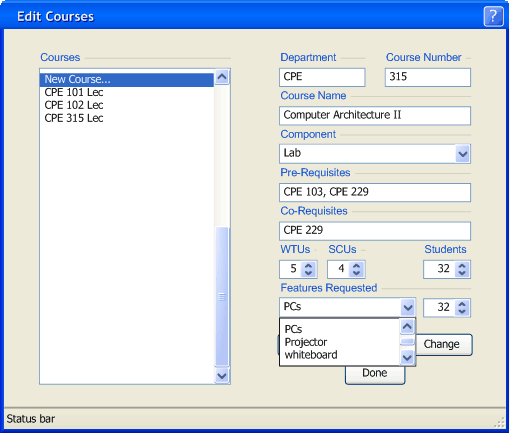
Figure 2.5.2.3: Example of Editing a Course
Once the Scheduling Administrator deems the amount of data describing the course to be sufficient, he/she Clicks on the 'Add' button. The software then adds the Course Record to the database and the course's department, number, and component, highlighted, to the list on the left.
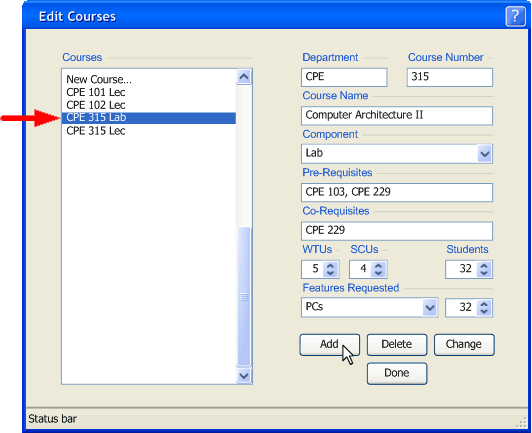
Figure 2.5.2.4: Example of Add/Change button results
Editing A Course
To edit a course, the Scheduling Administrator double-clicks on the desired entry in the scrolling list-box. The software then fills the data fields on the right with the known data corresponding to those fields. From here, editing is the same as adding a course to the Course Database, with the exception that the Scheduling Administrator then clicks the 'Change' button when sufficient data is entered. Upon successful completion, the software then highlights the course in list on the left.
To cancel an edit in progress, the Scheduling Administrator double-clicks on any other entry in the Room List. The software then displays a confirmation dialog denoting that the entry will not be saved:
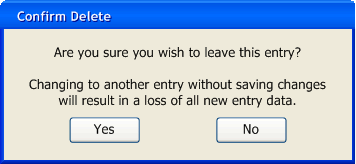
Figure 2.5.2.5: Confirm Loss of Editing Changes
The Scheduling Administrator clicks 'Yes' to confirm the loss of changes to the course or clicks 'No' to return to the editing operation. Both buttons close the Editing Loss Confirmation Dialog.
Errors and Special Cases
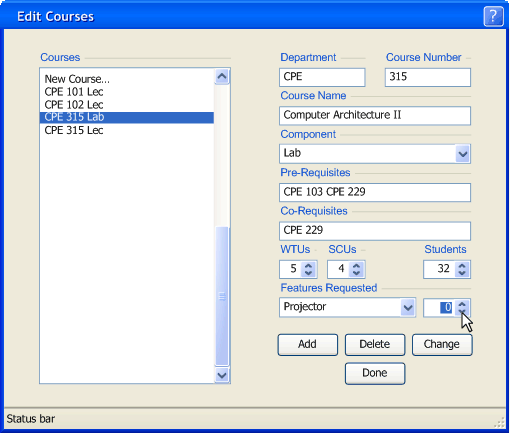
Figure 2.5.2.6: Special Modifications
The scheduling administrator now selects the CPE 315 Lab to edit it, then removes the comma from the Pre-Requisites field and sets the projector Feature Request count to 0, then clicks the 'Change' button.

Figure 2.5.2.7: Status bar error message
When an error in the formatting or contents of one of the fields occurs, the program generates a status bar message to inform the Scheduling Administrator of the error and also blocks any add or change operation. The Scheduling Administrator now replaces the missing comma, then clicks the 'Change' button.
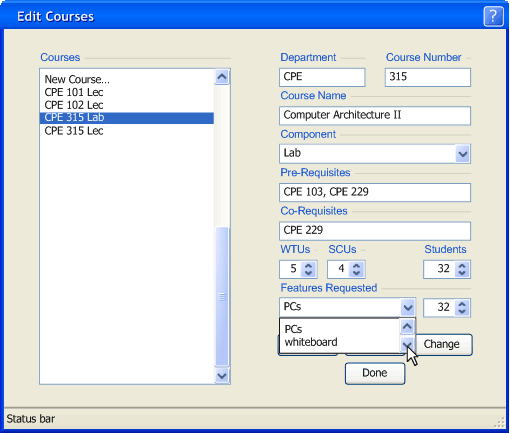
Figure 2.5.2.8: Feature Request Removed
Now that the Course Record has been successfully changed, the System Administrator examines the features of the room by clicking the arrow on the Features combo box. The software erased the projector feature because it interprets a Feature Request of count less than 1 to be non-existent.
Delete Course Dialog
To delete a course from the Course Database, the Scheduling Administrator double-clicks on a course in the list on the left as if to edit it, but instead then clicks the 'Delete' button. The software takes the Scheduling Administrator to the Delete Confirmation dialog:

Figure 2.5.2.9: Delete Course dialog
The Scheduling Administrator Clicks 'Yes' to confirm the deletion of the course, or clicks 'No' to cancel the delete operation. Both buttons close the Delete Confirmation Dialog.
Closing the Course Database Manager
To close the Course Database Management window, the Scheduling Administrator clicks on the 'Done' button; this returns the Scheduling Administrator to his/her previous view.
Prev: Room Database Editing
| Next: Teacher Database Editing
| Up: Administrator Database Editing
| Top: index









